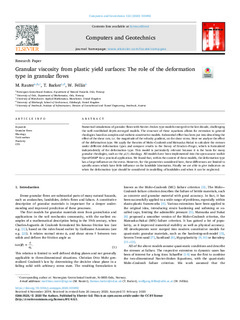Granular viscosity from plastic yield surfaces: The role of the deformation type in granular flows
Peer reviewed, Journal article
Published version

View/
Date
2020Metadata
Show full item recordCollections
- NGI articles [1027]
Original version
10.1016/j.compgeo.2020.103492Abstract
Numerical simulations of granular flows with Navier–Stokes type models emerged in the last decade, challenging the well established depth-averaged models. The structure of these equations allows for extension to general rheologies based on complex and realistic constitutive models. Substantial effort has been put into describing the effect of the shear rate, i.e. the magnitude of the velocity gradient, on the shear stress. Here we analyse the effect of the deformation type. We apply the theories of Mohr–Coulomb and Matsuoka–Nakai to calculate the stresses under different deformation types and compare results to the theory of Drucker–Prager, which is formulated independently of the deformation type. This model is particularly relevant because it is the basis for many granular rheologies, such as the –rheology. All models have been implemented into the open-source toolkit OpenFOAM® for a practical application. We found that, within the context of these models, the deformation type has a large influence on the stress. However, for the geometries considered here, these differences are limited to specific zones which have little influence on the landslide kinematics. Finally we are able to give indicators on when the deformation type should be considered in modelling of landslides and when it can be neglected.